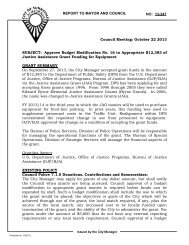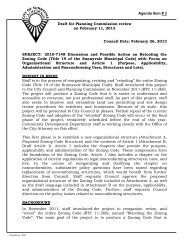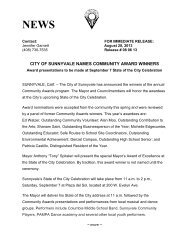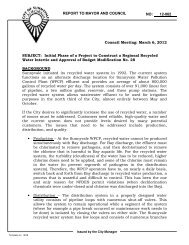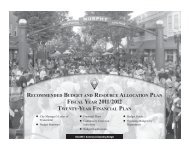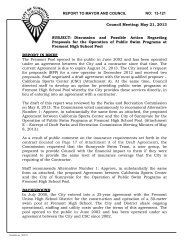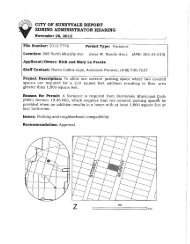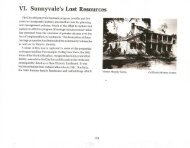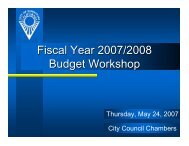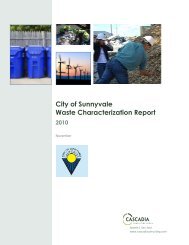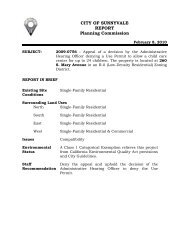12-294 - City of Sunnyvale - State of California
12-294 - City of Sunnyvale - State of California
12-294 - City of Sunnyvale - State of California
Create successful ePaper yourself
Turn your PDF publications into a flip-book with our unique Google optimized e-Paper software.
Page 6 <strong>of</strong> 16<br />
their employees. In other areas, excess parking is installed because there are<br />
unspoken incentives to overpark a business. Some businesses feel that<br />
abundant parking for customers is essential for success. Lenders may also<br />
contribute to the issue, as properties with high parking rates are considered<br />
more leasable than those with average amounts <strong>of</strong> parking. Creating a large<br />
number <strong>of</strong> parking spaces ensures that no customers are lost due to a<br />
perceived parking problem, and customers are not frustrated by a lack <strong>of</strong><br />
parking to access the business.<br />
Particularly with high-pr<strong>of</strong>ile retail centers, there is a stronger desire to<br />
establish parking which may or may not be used on a regular basis. New<br />
trends in online shopping and service provision have lowered demand, but<br />
business thinking and parking rates have not yet caught up with this trend.<br />
With the high cost <strong>of</strong> land, developers are more conscientious <strong>of</strong> development<br />
costs <strong>of</strong> parking.<br />
A maximum parking rate would limit the number <strong>of</strong> spaces built in a project.<br />
Regulating parking by maximum parking rates could be used effectively for<br />
commercial uses to create a baseline <strong>of</strong> how much parking is needed for<br />
average uses. An adjustment process could be included (see the next section)<br />
which would allow variation from minimums or maximums with<br />
documentation that the minimum or maximum is insufficient for business<br />
needs. Creating a maximum may prompt businesses to think more creatively<br />
about what parking they really need, and what steps can be taken during<br />
holiday seasons to address parking demand rather than just pave additional<br />
land area.<br />
Details about each <strong>of</strong> the rates are contained in the Parking White Paper<br />
(Attachment C). Where possible, staff attempted to design rates based on<br />
building characteristics rather than employment. Rates based on staffing levels<br />
(per employee) and based on small areas within the building (seating areas) are<br />
generally avoided. Staff notes that the two rates recommended for increase are<br />
convalescent hospitals and child care uses.<br />
Staff Recommendation: Staff recommends the following rates. Rates indicate<br />
the recommended number <strong>of</strong> parking spaces per 1,000 sq. ft. <strong>of</strong> gross floor<br />
area, unless otherwise specified. Arrows indicate whether the proposed rate<br />
has increased, decreased or stayed the same. Sideways arrows indicate that<br />
the rate is not proposed for change.



